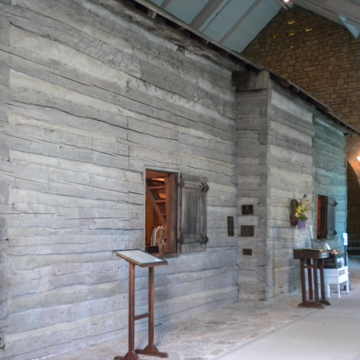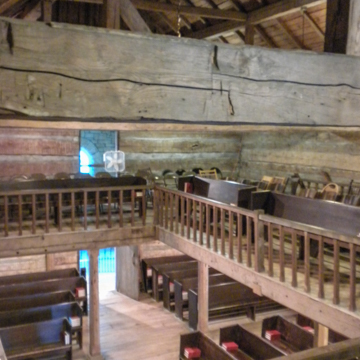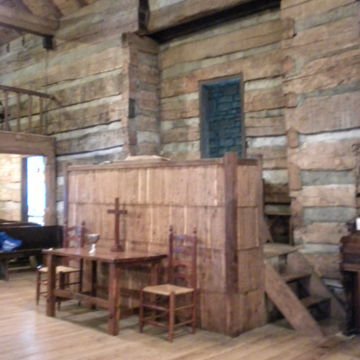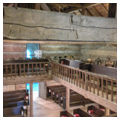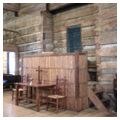Cane Ridge Meeting House, built in 1791, is one of Kentucky’s largest spaces enclosed within log walls. A decade after its ambitious construction, it witnessed the birth of a new religious denomination, the Christian Church (Disciples of Christ). The site resonates with the possibilities that frontier Kentuckians imagined in the resources at hand.
After visiting Bourbon County to verify Daniel Boone’s claims about the land’s fertility, Presbyterian Minister Robert Finley led a group of settlers from North Carolina to Kentucky in 1790. They settled eight miles east of present-day Paris. Within a year they had built homes, established farms, and erected this place of worship. A 30 x 50–foot building with 15–foot ceiling, the meetinghouse has long walls running north-to-south. Congregants entered through a door in the west gable end; a matching door opened in the east gable end. The minister preached from a pulpit in a narrow apse in the center of the north wall, which measured 2 x 8 feet. Three massive, 16-foot-square girders tied the long walls together at the plate level. A roof of clapboards, on wood sheathing, was held in place with wooden nails. Originally the building lacked windows and a fireplace; only shutters moderated the temperature. Originally, African Americans who worshipped in the building used an elevated wooden gallery. When this was removed in the 1830s, they occupied ground-floor seats.
Presbyterian minister Barton Stone became pastor at Cane Ridge in 1796. Stone sympathized with the growing religious movement of the Second Great Awakening, which emphasized personal and emotional spirituality, rather than doctrine and ritual. This preaching of individualistic spirituality sat well with rugged folk on the frontier. Horseback preachers aroused would-be congregations with animated sermons promising salvation through one's dedication to biblical principles. Occasional revivals served as key gatherings, where people could publicly declare their personal faith, and hope to witness mystical phenomena. In August 1801, a weekend revival at Cane Ridge church brought a throng estimated at 30,000. In 1804, a group of like-minded Presbyterian ministers from Kentucky and Ohio, including Barton Stone and Alexander Campbell, met at Cane Ridge seeking to establish an organization that would unite Christians along non-denominational lines. This group chose the simple term "Christian," stripped to its most basic, both in name and practice.
In 1829–1830, the Cane Ridge Meeting House underwent "repairs" that included plastering the interior walls, clapboarding its exterior, and installing a ceiling as well as wood planks to cover the dirt floor. Backs were added to the seats and the gallery was removed. These physical changes paralleled a desire to repair fractures in the nascent Christian Church, which, without fixed doctrine, found it difficult to maintain unity among various factions aligned with individual preachers. In 1832, these groups established a unified and more conventional religion—the Christian Church, Disciples of Christ, which continued to occupy the Cane Ridge Meeting House.
By the early 1920s, the church ceased to have regular services, and a fund for preserving the building was initiated. In 1932, at the centennial of the landmark meeting that led to the founding of the Disciples of Christ, the organization approved a plan to restore the meetinghouse and build a superstructure around it. The stone-walled superstructure, evocative of a country church, enclosed the historic log church; about fifteen feet of space surrounds the outside walls of the meeting house and inside walls of the superstructure. Dedicated on June 30, 1959, the superstructure provides a stable environment for the Meeting House, and has preserved it in remarkable condition for more than 50 years. Reflecting an early recognition of the building’s importance, the Historic American Buildings Survey documented Cane Ridge in 1934. Cane Ridge Meeting House continues to function as a church and is open to the public.
References
Polsgrove, Robert, Michael Crain, and Elaine Norton Boylen. "‘Raccoon’ John Smith House,” Woodford County, Kentucky. National Register of Historic Places Inventory-Nomination Form, 2011. National Park Service, U.S. Department of the Interior, Washington, DC.
Rhodes Thompson, Cane. Ridge Meeting House: A Temple of Christian Unity Souvenir BookletParis, KY: Cane Ridge Preservation Project, 1957.

